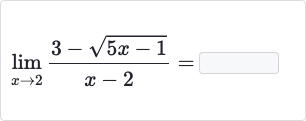AI tutor
Full solution
Q.
- Identify the form: Identify the form of the limit.Substitute into the function to see if the limit can be directly calculated.This is an indeterminate form, so we cannot directly calculate the limit.
- Substitute and check: Apply L'Hôpital's Rule.Since we have an indeterminate form of , we can apply L'Hôpital's Rule, which states that if the limit as approaches of is or , then the limit is the same as the limit of the derivatives of the numerator and the denominator.So, we need to find the derivatives of the numerator and the denominator.
- Apply L'Hôpital's Rule: Differentiate the numerator and the denominator.The derivative of the numerator with respect to is:The derivative of the denominator with respect to is:
- Differentiate numerator and denominator: Apply L'Hôpital's Rule using the derivatives.Now we take the limit of the derivatives:
- Apply Rule with derivatives: Calculate the limit of the derivatives.Substitute into the derivative of the numerator:
More problems from Identify equivalent linear expressions I
QuestionGet tutor help

